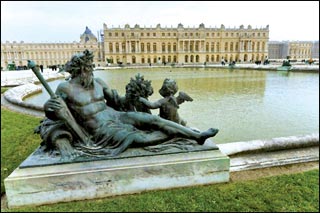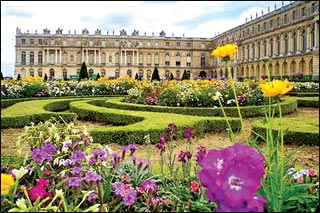Grandeur of Versailles Palace
Hemakumar NANAYAKKARA
The extravagant Royal Palace of Versailles is situated in a small
town named Versailles, about 20 km southwest of Paris. Versailles Palace
is known to be the most famous palace and garden combination in Europe ,
most possibly in the world. The whole complex became a source of
inspiration for many lately constructed palaces in Europe.
Versailles was the hunting ground of King Louis XIII , he eventually
became fascinated with it's enchanting landscape. In 1622 the King
purchased the land and built a small Hunting Lodge at this site. In a
couple of years time he began to enlarge his lodge. Soon he purchased
more land to expand his territory in Versailles.
Then, in 1662 , the sun king Louis XIV took a great interest in the
land of Versailles as he distrusted the Parisians and was very keen to
move his Royal Residence away from Louvre Palace , which was the center
of constant political turbulance at that time.
|

Hall of Mirrors. Picture courtesy: www.versailleslimosines.com |
|

Orangerie of Versailles Gardens. Picture courtesy: www.
wikispaces.com |
|

Versailles Gardens. Picture courtesy: www.naturehills.com |
The King Louis XIV had grown up during a time of a civil war between
rival factions of aristocrats and strongly wanted to go to a rather
quiet place where he could well organize and take complete control of
the government of France. King Louis XIV consulted architect Louis Le
Vau along with artist Charles Le Brun and asked them to carry out the
work of constructing the new Versailles Palace. The king has also
appoined Andre Le Notre, a well known gardner of that time as the
architect of the Versailles Palace Gardens.
The Garden of the Palace Versailles is located to the west of the
palace and it surrounds by about 800 hectares of perfectly maintained
land.
The Palace garden includes roughly 1400 fountains , using water
pumped up from river Seine. Also it has hundreds of marble and bronze
sculptures and many attractive water ponds.The Grand Canal, a cross
shaped water body which divides Versailles Palace Gardens is 1.6 km long
and messures 6 km around it's edges.
Soon after the death of architect Le Vau , the king hired a
relatively unknown yet very talented designer named Jules Hardouin -
Mansart for the completion of the construction work at Versailles.
Mansart tripled the size of the palace and added the nothern and
southern wings, the Orangerie, the grand Trianon (a chateau) and the
famous Royal Chapel to the main structure of Versailles Palace.During
this period, King Louis XIV moved the base of French Monarchy from Paris
to Versailles.
In 1748 the Versailles Opera was designed and built by Jaques-Ange
Gabriel for the King Louis XV and then between 1761-1764 the Petit
Trianon (a small chateau) was constructed for the King Louis XV and
Madame de Pompadour.
Under the rule of King Louis XVI, there were futher plans to extend
the structure of the palace, a competion for a master design was held
during the period of this king's rule. The French Revolution (1789-
1799) perished the king's reign and his construction plans as well.
During the revolution a great collection of art was transfered from
Versailles Palace to the Louvre. Valuble furniture and decors were sold
off at auctions.
After the revolution, Napoleon spent most of his summers in
Versailles Palace.
Later in 1837 Louis - Phillipe transformed the magnificiant baroque
palace into a grand museum.
The Hall of Mirrors is the central gallery of Versailles Palace. It
is considered to be one of the most famous rooms in the world.The Hall
of Mirrors is 73 meters long, 10.5 meters wide and 12.3 meters high.
It's flanked by two wonderful salons, to the north the Salon of War and
to the south the Salon of Peace. The main feature of this elegant hall
is the seventeen mirror clad arches which reflect the seventeen archaded
windows that overlook the beautiful Palace Gardens. Each mirror arch
contained 21 mirrors, with a total of 357 mirrors used in the main
decoration.
The mirrors were made in France with the assistance of well
experienced Venetian workers. Both mirrors and glasses very expensive
during the 17th century.
Exclusive chandeliers were hung from the arched, ornately painted
ceiling and a row of gilded, sculptured, gold gueridons were placed in
front of the seventeen arched windows and the mirrors..
The ceiling is decorated with allegorical paintings by Le Brun
proclaiming important achievements of King Louis XIV and France between
1661-1678.
The Hall of Mirrors is the most privileged part of Versailles Palace.
The Hall of Mirrors wad chosen by the former Prime Minister of France
Georges Clemenceau to sign the Treaty of Versailles, which officially
ended World War I on June 28, 1919. |



